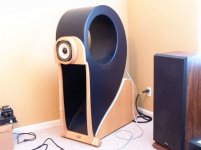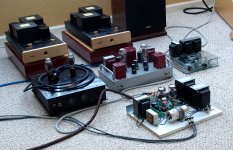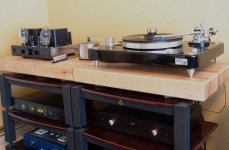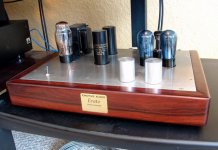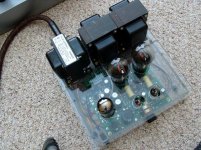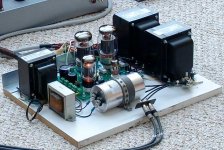Audiophile term: "HIP test"
My wife and I just came from furniture shopping for the music room. The criteria was that it had to fit two people comfortably and be under 72" inches long (6 ft). We agreed that two chairs would provide a more flexible arrangement, but a couch or love seat would make better use of the space.
In the end we bought a leather love seat with a storage ottoman. Before everything was said and done, however, I submitted my wife to the "HIP test" - that is, we both sat on opposite sides of the love seat against our respective arm rests and made sure that our hips and legs did not touch.
At this point my wife was suspecting something was up and she gave a smirk and a raised eyebrow, to which I had to explain the rationale of the whole thing was to make sure that when the "guys" were over for a listening session our butts and legs did not touch!
Hence the name "HIP test".
Feedback welcome,
-- josé k.
My wife and I just came from furniture shopping for the music room. The criteria was that it had to fit two people comfortably and be under 72" inches long (6 ft). We agreed that two chairs would provide a more flexible arrangement, but a couch or love seat would make better use of the space.
In the end we bought a leather love seat with a storage ottoman. Before everything was said and done, however, I submitted my wife to the "HIP test" - that is, we both sat on opposite sides of the love seat against our respective arm rests and made sure that our hips and legs did not touch.
At this point my wife was suspecting something was up and she gave a smirk and a raised eyebrow, to which I had to explain the rationale of the whole thing was to make sure that when the "guys" were over for a listening session our butts and legs did not touch!
Hence the name "HIP test".
Feedback welcome,
-- josé k.
Sounds like a good addition to the list of Man Laws LOL!<p>
Two men shall not allow eachother's butts or hips to touch while sitting on a couch/ loveseat unless solely for the purpose of auditioning new gear. [P]The number of selections to be listened to, will be agreed upon in advance, after which time, the guest will find another seat, relinquishing the sweet spot to the owner.
Two men shall not allow eachother's butts or hips to touch while sitting on a couch/ loveseat unless solely for the purpose of auditioning new gear. [P]The number of selections to be listened to, will be agreed upon in advance, after which time, the guest will find another seat, relinquishing the sweet spot to the owner.
Two men shall not allow each other's butts or hips to touch while sitting on a couch/ loveseat unless solely for the purpose of auditioning new gear. [P]The number of selections to be listened to, will be agreed upon in advance, after which time, the guest will find another seat, relinquishing the sweet spot to the owner.
Sounds just about right to me..
I was invited to member "korneluk"s house today for a listening test. I can attest that the couch does pass the "HIP test". Now that I have returned home, I can't however even remember the couch. Why? Because of all of the absolutely AWESOME tube audio equipment in the room. I can remember 11 pieces of vacuum tube equipment (counting the 2 amps I brought).
I took my Lexan TubelabSE, a (still unfinished) SimpleSE, and a box full of tubes, and headed North.
When I arrived, I grabbed an amp in each hand, and went inside. As I carried my equipment up the stairs, I could hear someone playing the sax in the room. No, this sound was coming from speakers.
The music was playing from a SACD player through a 27 based line stage into a Korneff 45 amplifer. I can not now remember the brand name on the speakers but they were giant horns with Lowther drivers.
I took my Lexan TubelabSE, a (still unfinished) SimpleSE, and a box full of tubes, and headed North.
When I arrived, I grabbed an amp in each hand, and went inside. As I carried my equipment up the stairs, I could hear someone playing the sax in the room. No, this sound was coming from speakers.
The music was playing from a SACD player through a 27 based line stage into a Korneff 45 amplifer. I can not now remember the brand name on the speakers but they were giant horns with Lowther drivers.
Attachments
There were several tube amplifiers in the room. All of them were SE amps. The previously mentioned Korneff and a Moth 2A3's would be listened to today.
Jose, told my that he did not need any more than 1 or 2 watts. His speakers were 106 db efficient. I understand the math (2 watts through 106db speakers sounds like 20 watts through 96db speakers, and 200 watts through 86 db speakers), but It is hard for me to realize how anyone could be happy with 1 watt.
Nevertheless, I brought my TubelabSE with the NX-483 tubes. It makes about 1.5 to 2 watts. I also brought a SimpleSE with a wide selection of tubes. The amp was wired for UL mode with cathode feedback, since I run it that way. I need about 10 watts to wake up my 86db Yamaha speakers.
Jose, told my that he did not need any more than 1 or 2 watts. His speakers were 106 db efficient. I understand the math (2 watts through 106db speakers sounds like 20 watts through 96db speakers, and 200 watts through 86 db speakers), but It is hard for me to realize how anyone could be happy with 1 watt.
Nevertheless, I brought my TubelabSE with the NX-483 tubes. It makes about 1.5 to 2 watts. I also brought a SimpleSE with a wide selection of tubes. The amp was wired for UL mode with cathode feedback, since I run it that way. I need about 10 watts to wake up my 86db Yamaha speakers.
Attachments
Vinyl? Of course. I thought I was set with my 25 year old Technics direct drive turntable. It was cool with my Pioneer receiver in the 1970's and it sounded awesome with my Phase Linear / Carver setup in the 90's. I never even knew that turntable setups like this existed.
The box on the lower left is the controller. It provides 115 volts AC to the motor. The frequency is adjustable, to control the motor speed.
The box on the right is the Melos phono stage.
The records were very quiet. No hiss, snap crackle pop stuff. Just clear music.
The box on the lower left is the controller. It provides 115 volts AC to the motor. The frequency is adjustable, to control the motor speed.
The box on the right is the Melos phono stage.
The records were very quiet. No hiss, snap crackle pop stuff. Just clear music.
Attachments
I was interrupted during posting these pictures last night by a call from a friend who told me of the passing of one of my coworkers from the factory days 30 years ago. These calls are coming far too often now. It seems that at least 10 of my friends from the old days have contracted cancer. Only 2 have survived, 2 more have developed "mystery illnesses" that have not been identified by doctors.
I continue:
The 27 based line stage is shown below.
I continue:
The 27 based line stage is shown below.
Attachments
I was invited to bring a couple of amps to Jose's house, so I got my TubelabSE out of the closet where it has been hiding. I remembered its last visit to some high efficiency speakers, where it went HUMMMMMMM. I had fixed this by rotating the power transformer 90 degrees, but these were 106db speakers.
I decided that my CRC power supply was going to become a CLC power supply. I found a power choke of unknown specifications, but 150 ohm DCR, so I wired it in place of the 150 ohm resistor in the power supply. I tested the amp, removed the tubes for transport, and put the amp in the trunk of my car. I also unhooked my SimpleSE, gathered up about 15 pairs of tubes, and headed out.
After listening to a few selections through the Korneff 45, with some monster "45" tubes (300B sized), and Electra Print transformers with shiny Nickel cores, I was beginning to think that my amps could never sound this good.
We connected the TubelabSE with the 76 year old NX-483 tubes (a 5 volt 45), powered it up, and there was NO hum audible with my ear to the speaker. We played some of the same musical selections as before, and we agreed that the two amps sounded very similar. The TubelabSE may have been slightly "brighter". The differences were subtle.
Next, we connected up the SimpleSE, as it was configured in my lab, with the very used "Coke Bottle" 6L6's in UL with cathode feedback. This was not pretty. As soon as it came up, I could hear that something was not right. The combination that worked best on my 86db speakers, didn't work here. The "bass was not right" and the mids sounded harsh. Switching to triode mode, and turning off the cathode feedback solved the harshness. Jose suggested that I try a different pair of tubes, so I plugged it a pair of Electro Harmonix KT88's. No adjustments were needed, and the amp came to life. We listened to it for the rest of the afternoon, and never got around to trying any of the other tubes that I brought.
Jose's super critical listening still heard something that was not right in the bass frequencies. Neither I or the other listener, Ashley, noticed this. We surmised that the Hammond 1628SEA's were somehow causing it. We agreed that there would be more of these sessions, and I will have more amps next time. I could even bring the test amp and a few hundred pounds of transformers. None of the Hammond 1628SEA treble rolloff was noticed. We listened to CD's SACD's and vinyl and all of it was good.
The previously written "man law" was not violated because Ashley and I sat on opposite ends of the couch, while Jose " played the tunes".
As I was packing up to leave, Jose connected up the Moth 2A3 amp. It had a clearly different sound, but in a good way. It would have been interesting to try 2A3's in the TubelabSE to see if the tubes were responsible for the difference.
I decided that my CRC power supply was going to become a CLC power supply. I found a power choke of unknown specifications, but 150 ohm DCR, so I wired it in place of the 150 ohm resistor in the power supply. I tested the amp, removed the tubes for transport, and put the amp in the trunk of my car. I also unhooked my SimpleSE, gathered up about 15 pairs of tubes, and headed out.
After listening to a few selections through the Korneff 45, with some monster "45" tubes (300B sized), and Electra Print transformers with shiny Nickel cores, I was beginning to think that my amps could never sound this good.
We connected the TubelabSE with the 76 year old NX-483 tubes (a 5 volt 45), powered it up, and there was NO hum audible with my ear to the speaker. We played some of the same musical selections as before, and we agreed that the two amps sounded very similar. The TubelabSE may have been slightly "brighter". The differences were subtle.
Next, we connected up the SimpleSE, as it was configured in my lab, with the very used "Coke Bottle" 6L6's in UL with cathode feedback. This was not pretty. As soon as it came up, I could hear that something was not right. The combination that worked best on my 86db speakers, didn't work here. The "bass was not right" and the mids sounded harsh. Switching to triode mode, and turning off the cathode feedback solved the harshness. Jose suggested that I try a different pair of tubes, so I plugged it a pair of Electro Harmonix KT88's. No adjustments were needed, and the amp came to life. We listened to it for the rest of the afternoon, and never got around to trying any of the other tubes that I brought.
Jose's super critical listening still heard something that was not right in the bass frequencies. Neither I or the other listener, Ashley, noticed this. We surmised that the Hammond 1628SEA's were somehow causing it. We agreed that there would be more of these sessions, and I will have more amps next time. I could even bring the test amp and a few hundred pounds of transformers. None of the Hammond 1628SEA treble rolloff was noticed. We listened to CD's SACD's and vinyl and all of it was good.
The previously written "man law" was not violated because Ashley and I sat on opposite ends of the couch, while Jose " played the tunes".
As I was packing up to leave, Jose connected up the Moth 2A3 amp. It had a clearly different sound, but in a good way. It would have been interesting to try 2A3's in the TubelabSE to see if the tubes were responsible for the difference.
Attachments
Conclusions:
The TubelabSE could hold its own against the other 2 amps. The SimpleSE with no feedback, KT88's in triode mode sounded almost as good. I would have liked to hear some of the other tubes and a few different transformers. That will happen another day.
The TubelabSE could hold its own against the other 2 amps. The SimpleSE with no feedback, KT88's in triode mode sounded almost as good. I would have liked to hear some of the other tubes and a few different transformers. That will happen another day.
Attachments
No. I didn't get to try that combination. Maybe next time.
I guess the conclusion that I forgot to write up is that what works best for one set of speakers may be a poor combination on another set. This was obvious on Sunday, but there is 20db of efficiency difference in my small speakers and his.
I guess the conclusion that I forgot to write up is that what works best for one set of speakers may be a poor combination on another set. This was obvious on Sunday, but there is 20db of efficiency difference in my small speakers and his.
Those are Hammond 1628SEA. They are large, have wall shaking bass on my big speakers and sound pretty good on my small speakers. If you find yourself using a sizeable percentage of your amps power, and have speakers big enough to make use of the bass that the Hammonds can produce, these are a good choice. On my small speakers, I will probably use smaller transformers because the speakers don't make any sound below 70 HZ.
It was noticed by Jose, that the "bass didn't sound quite right" through his speakers. Neither of the other listeners noticed it. It did not stop us from listening to it for most of the afternoon.
We believe that this may be due to the massive size of the OPT's and the fact that they (due to their size) have the most loss of all the transformers that I bench tested a while back. The iron losses tend to be nonlinear due to magnetic hysteresis and other factors. Some of the hysteresis related factors tend to be constant. My normal listening levels are in the 5 to 10 watt range (86db speakers) where the constant effects would be a small percentage of the sound power. The average listening level at Jose's house was probably far less than 1 watt.
How to we test our theory? We repeat the testing using the same amp and a box full of different OPT's. We will get to this, I just don't know when. I never had an opportunity to hear his system before and when we got a combination that sounded good (very good, I might add) we just listened to it!
It was noticed by Jose, that the "bass didn't sound quite right" through his speakers. Neither of the other listeners noticed it. It did not stop us from listening to it for most of the afternoon.
We believe that this may be due to the massive size of the OPT's and the fact that they (due to their size) have the most loss of all the transformers that I bench tested a while back. The iron losses tend to be nonlinear due to magnetic hysteresis and other factors. Some of the hysteresis related factors tend to be constant. My normal listening levels are in the 5 to 10 watt range (86db speakers) where the constant effects would be a small percentage of the sound power. The average listening level at Jose's house was probably far less than 1 watt.
How to we test our theory? We repeat the testing using the same amp and a box full of different OPT's. We will get to this, I just don't know when. I never had an opportunity to hear his system before and when we got a combination that sounded good (very good, I might add) we just listened to it!
Make sure that whoever you order them from has the 1628SEA not the older 1628SE. The newer transformers have far better high frequency response. One of the popular Hammond vendors shipped me 3 year old 1628SE's. They said that I could return them, but shipping would be $50. I kept them, and one wound up in a guitar amp, and the other is still on my shelf.
- Status
- This old topic is closed. If you want to reopen this topic, contact a moderator using the "Report Post" button.
- Home
- Amplifiers
- Tubes / Valves
- Audiophile term: "HIP test"
